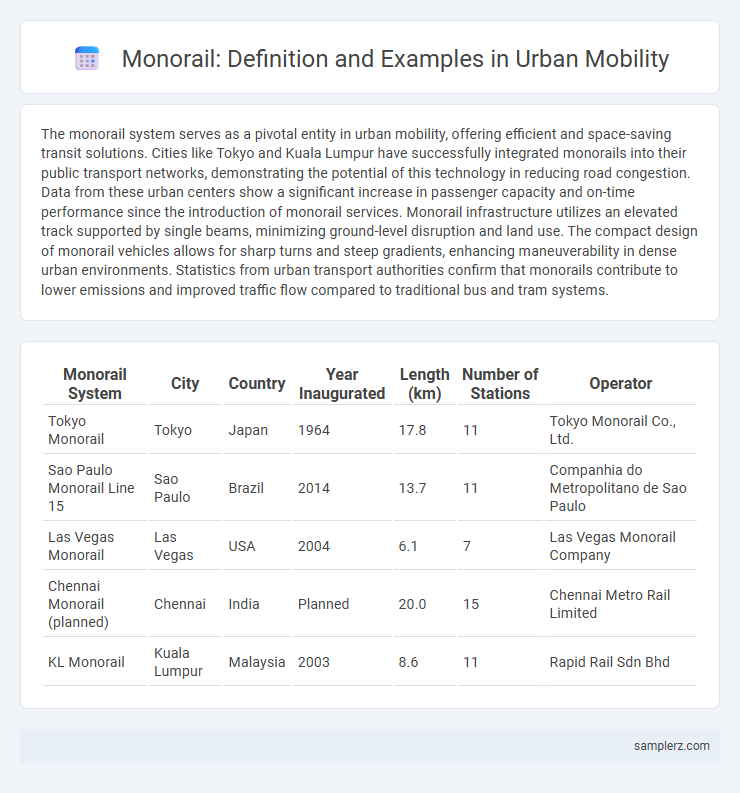The monorail system serves as a pivotal entity in urban mobility, offering efficient and space-saving transit solutions. Cities like Tokyo and Kuala Lumpur have successfully integrated monorails into their public transport networks, demonstrating the potential of this technology in reducing road congestion. Data from these urban centers show a significant increase in passenger capacity and on-time performance since the introduction of monorail services. Monorail infrastructure utilizes an elevated track supported by single beams, minimizing ground-level disruption and land use. The compact design of monorail vehicles allows for sharp turns and steep gradients, enhancing maneuverability in dense urban environments. Statistics from urban transport authorities confirm that monorails contribute to lower emissions and improved traffic flow compared to traditional bus and tram systems.
Table of Comparison
| Monorail System | City | Country | Year Inaugurated | Length (km) | Number of Stations | Operator |
|---|---|---|---|---|---|---|
| Tokyo Monorail | Tokyo | Japan | 1964 | 17.8 | 11 | Tokyo Monorail Co., Ltd. |
| Sao Paulo Monorail Line 15 | Sao Paulo | Brazil | 2014 | 13.7 | 11 | Companhia do Metropolitano de Sao Paulo |
| Las Vegas Monorail | Las Vegas | USA | 2004 | 6.1 | 7 | Las Vegas Monorail Company |
| Chennai Monorail (planned) | Chennai | India | Planned | 20.0 | 15 | Chennai Metro Rail Limited |
| KL Monorail | Kuala Lumpur | Malaysia | 2003 | 8.6 | 11 | Rapid Rail Sdn Bhd |
Introduction to Monorail Systems in Urban Mobility
Monorail systems offer an efficient urban mobility solution by operating on a single rail elevated above ground, reducing traffic congestion and land use compared to traditional railways. Cities like Tokyo and Sao Paulo have successfully integrated monorails into their public transit networks, enhancing passenger flow and connectivity in densely populated areas. Their quiet operation and ability to navigate sharp curves and steep gradients make monorails ideal for complex urban environments.
Historical Evolution of Monorail Transport
The historical evolution of monorail transport began in the early 19th century, with the first operational systems emerging in the late 1800s, exemplified by the Bennie Railplane in 1929. Urban monorails gained prominence in the mid-20th century as innovative solutions to congestion, highlighted by Tokyo's iconic Shonan Monorail launched in 1970. Modern urban monorails integrate advanced magnetic levitation and automated control systems, enhancing efficiency and sustainability in densely populated cities.
Key Features of Monorail Technology
Monorail technology in urban mobility features a single-rail elevated track system that minimizes ground-level congestion and reduces the urban footprint. Key attributes include a lightweight, automated design enabling high-frequency, efficient passenger flow with low noise and energy consumption. Advanced safety systems and smooth acceleration make monorails ideal for dense city environments, optimizing mass transit without requiring extensive infrastructure.
Notable Monorail Networks Worldwide
The Tokyo Monorail, one of the busiest monorail systems globally, efficiently connects Haneda Airport to central Tokyo, handling over 100 million passengers annually. The Sao Paulo Monorail in Brazil is notable for its rapid transit capabilities, spanning 17.7 kilometers and alleviating congestion in one of the largest metropolitan areas in South America. In Kuala Lumpur, the KL Monorail serves as a critical link within the urban transit network, enhancing mobility across the city and integrating seamlessly with other public transport systems.
Case Study: Tokyo Monorail and City Connectivity
The Tokyo Monorail exemplifies efficient urban mobility by connecting Haneda Airport with central Tokyo, covering a distance of 17.8 kilometers in just 18 minutes. This monorail system enhances city connectivity by integrating seamlessly with other transit networks like JR East and Tokyo Metro, facilitating smooth passenger transfers. Its high-frequency service combined with reliable punctuality significantly reduces urban congestion and supports sustainable transportation in Tokyo's metropolitan area.
Monorails vs. Other Urban Transport Modes
Monorails offer a space-efficient alternative to traditional urban transport modes, utilizing elevated tracks that reduce ground-level congestion and minimize land use. Compared to buses and trams, monorails provide smoother, quieter rides with fewer emissions, enhancing urban air quality and passenger comfort. Their ability to integrate seamlessly into dense cityscapes without extensive infrastructure modifications makes them a competitive solution for sustainable urban mobility.
Environmental Benefits of Monorail Systems
Monorail systems reduce urban air pollution by emitting zero direct greenhouse gases, significantly lowering the carbon footprint compared to traditional gasoline-powered vehicles. Their elevated tracks minimize land use and disturbance to existing ecosystems, preserving green spaces in densely populated urban areas. Energy-efficient electric propulsion further decreases reliance on fossil fuels, contributing to sustainable city transportation and improved air quality.
Challenges in Monorail Implementation
Monorail implementation in urban mobility faces significant challenges such as high construction costs and complex integration with existing transportation networks. Limited route flexibility and land acquisition disputes often delay project timelines and increase expenditures. Safety concerns and technological maintenance requirements further complicate the deployment of monorail systems in densely populated cities.
Future Prospects for Monorail in Urban Development
Monorail systems offer a sustainable and space-efficient solution for urban transportation, with future prospects including integration with smart city technologies and renewable energy sources. Innovations in automated control and lightweight materials are set to enhance monorail efficiency and reduce operational costs. Expanding monorail networks can alleviate urban congestion while promoting seamless connectivity in rapidly growing metropolitan areas.
Public Perception and Social Impact of Monorails
Monorails in urban mobility often face mixed public perception, with users appreciating their sleek design and reduced ground-level congestion while critics highlight concerns about limited coverage and high construction costs. Social impact studies indicate monorails can improve accessibility in densely populated areas, fostering economic growth and reducing reliance on traditional vehicles. Public acceptance tends to increase when monorail systems demonstrate efficiency, safety, and integration with existing transit networks.

example of monorail in urban movement Infographic
 samplerz.com
samplerz.com